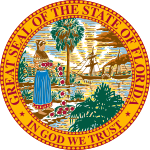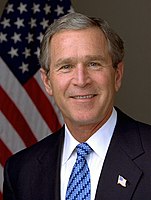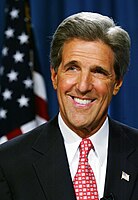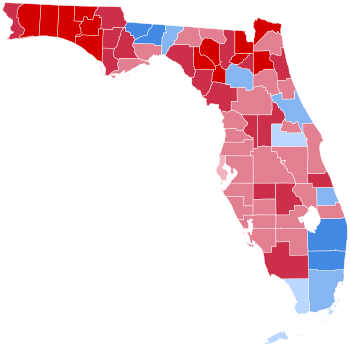
A | B | C | D | E | F | G | H | CH | I | J | K | L | M | N | O | P | Q | R | S | T | U | V | W | X | Y | Z | 0 | 1 | 2 | 3 | 4 | 5 | 6 | 7 | 8 | 9
| ||||||||||||||||||||||||||
| Turnout | ||||||||||||||||||||||||||
|---|---|---|---|---|---|---|---|---|---|---|---|---|---|---|---|---|---|---|---|---|---|---|---|---|---|---|
| ||||||||||||||||||||||||||
| ||||||||||||||||||||||||||
| ||||||||||||||||||||||||||
The 2004 United States presidential election in Florida took place on November 2, 2004, as part of the 2004 United States presidential election. Voters chose 27 representatives, or electors to the Electoral College, who voted for president and vice president.
Florida was won by incumbent President George W. Bush by a 5.01% margin of victory. Prior to the election, most news organizations considered this a swing state that was leaning towards Bush. Once again, Florida was under the national spotlight due to its high number of electoral votes and the fresh memory of the controversy surrounding the 2000 Florida vote. Turnout was much higher, going from an estimated 6 million voters in 2000 to over 7.5 million voters showing up to vote in 2004.[2] This remains the last time that any candidate won Florida by a greater than 5% margin and the last time a Republican won a majority of the state's popular vote until 2020.
Campaign
Predictions
There were 12 news organizations who made state-by-state predictions of the election. Here are their last predictions before election day.[3]
| Source | Ranking |
|---|---|
| D.C. Political Report | Lean R |
| Associated Press | Toss-up |
| CNN | Likely R |
| Cook Political Report | Toss-up |
| Newsweek | Toss-up |
| New York Times | Toss-up |
| Rasmussen Reports | Toss-up |
| Research 2000 | Toss-up |
| Washington Post | Toss-up |
| Washington Times | Toss-up |
| Zogby International | Toss-up |
| Washington Dispatch | Likely R |
Polling
| Poll source | Date(s) administered |
Sample size |
Margin of error |
John Kerry (D) |
George W. Bush (R) |
Ralph Nader (I) |
Other | Undecided |
|---|---|---|---|---|---|---|---|---|
| Quinnipiac | October 27–31, 2004 | 1,098 | ± 3.3 | 43% | 51% | 1% | 0% | 4% |
| Quinnipiac | October 22–26, 2004 | 944 | ± 3.2 | 46% | 49% | 1% | 0% | 4% |
| Quinnipiac | October 15–19, 2004 | 808 | ± 3.5 | 47% | 48% | 1% | 0% | 4% |
| Quinnipiac | October 1–5, 2004 | 717 | ± 3.7 | 44% | 51% | 0% | 0% | 5% |
| Quinnipiac | September 18–21, 2004 | 819 | ± 3.4 | 41% | 49% | 5% | 0% | 5% |
| Quinnipiac | August 5–10, 2004 | 1,094 | ± 3.0 | 47% | 41% | 4% | 0% | 7% |
| Quinnipiac | June 23–27, 2004 | 1,209 | ± 2.8 | 43% | 43% | 5% | 1% | 9% |
Throughout the general election, candidates exchanged narrow leads in the state. The final 3 poll averaged showed Bush leading with 49% to Kerry's 47%.[4]
Fundraising
Bush raised $16,956,510.[5] Kerry raised $7,285,151.[6]
Advertising and visits
This state was heavily targeted as a swing state. Over the course of the election, Bush visited the state 15 times to Kerry's 18 times. Also, both candidates spent heavily on television advertisements, spending an estimated $3 million each week.[7]
Analysis
During the 2004 U.S. presidential election, numerous allegations of irregularities were made concerning the voting process in Florida. These allegations included missing and uncounted votes, machine malfunction, and a lack of correlation between the vote count and exit polling.
In the prior election, Ralph Nader obtained over 2% of the vote, thus Bush won with less than 50% of the vote, making his approval rating and his brother's approval ratings the deciding factor of the state. Polls throughout the campaign indicated that Florida was too close to call, prompting concerns about a repeat of the 2000 fiasco. However, the high popularity of George W. Bush's brother, Republican Governor Jeb Bush, contributed to a relatively comfortable victory for Bush, by a margin of 5% over his Democratic rival, John Kerry. Despite this, Florida remained the most Democratic of the 11 states of the former Confederacy, and Kerry's 5% loss in Florida was the closest he came to carrying any Confederate state.
While the South Florida metropolitan area mostly voted for Kerry, the other parts of the state mainly supported Bush, being culturally closer to the rest of the southern United States than to Miami, home to large Hispanic and Jewish populations, as well as retirees and transplants from the largely liberal Northeastern United States.
Key to Bush's victory was increased turnout in Republican areas. Bush's margin of victory in several counties topped 70%, particularly in the Florida Panhandle. Bush also won a significant number of heavily populated and fast-growing areas including Jacksonville, the entire Tampa Bay area, Southwest Florida, Orlando, the Space Coast, and Ocala.
As of the 2020 presidential election[update], this is the last election in which Hillsborough County and Osceola County voted for the Republican candidate. This is also the last time that the cities of Orlando, Tampa, and Kissimmee have voted Republican in a presidential election.
Results
| Elections in Florida |
|---|
 |




